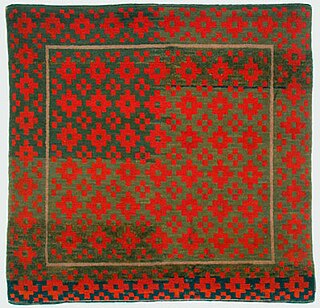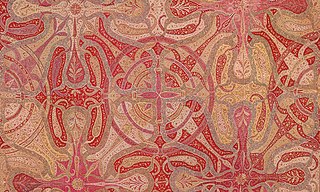
A carpet is a textile floor covering typically consisting of an upper layer of pile attached to a backing. The pile was traditionally made from wool, but since the 20th century synthetic fibers such as polypropylene, nylon, or polyester have often been used, as these fibers are less expensive than wool. The pile usually consists of twisted tufts that are typically heat-treated to maintain their structure. The term carpet is often used in a similar context to the term rug, but rugs are typically considered to be smaller than a room and not attached to the floor.

Tibetan rug making is an ancient, traditional craft. Tibetan rugs are traditionally made from Tibetan highland sheep's wool, called changpel. Tibetans use rugs for many purposes ranging from flooring to wall hanging to horse saddles, though the most common use is as a seating carpet. A typical sleeping carpet measuring around 3 ft × 5 ft is called a khaden.

A Persian carpet or Persian rug, also known as Iranian carpet, is a heavy textile made for a wide variety of utilitarian and symbolic purposes and produced in Iran, for home use, local sale, and export. Carpet weaving is an essential part of Persian culture and Iranian art. Within the group of Oriental rugs produced by the countries of the "rug belt", the Persian carpet stands out by the variety and elaborateness of its manifold designs.

Pashmina refers to, depending on the source, the cashmere wool of the Changthangi cashmere goat, for fine Kashmiri cashmere wool or a synonym for cashmere wool.

A shawl is a simple item of clothing, loosely worn over the shoulders, upper body and arms, and sometimes also over the head. It is usually a rectangular piece of cloth, but can also be square or triangular in shape. Other shapes include oblong shawls. It is associated with the inhabitants of the northern Indian subcontinent—particularly Kashmir and Punjab—and Central Asia, but can be found in many other parts of the world.

The Iranian city of Isfahan has long been one of the centres for production of the famous Persian carpet. Isfahani carpets are renowned for their high quality. The most famous workshop in Isfahan is Seirafian. In Europe, they became incorrectly known as Polish rugs because of the trade route from Persia to France running through Poland.

Uşak carpets, Ushak carpets or Oushak Carpets are Turkish carpets that use a particular family of designs, called by convention after the city of Uşak, Turkey – one of the larger towns in Western Anatolia, which was a major center of rug production from the early days of the Ottoman Empire, into the early 20th century.
An oriental rug is a heavy textile made for a wide variety of utilitarian and symbolic purposes and produced in "Oriental countries" for home use, local sale, and export.

Qom rugs are made in the Qom Province of Iran, around 100 km south of Tehran. Although rug weaving in Qom was not a major industry until the past 100 years, the luxurious silk and wool rugs of Qom are known for their high quality and are regarded among the most expensive in the world. Persian Qum rugs are often considered as investment, because their value is constantly increasing.

Anatolian rug is a term of convenience, commonly used today to denote rugs and carpets woven in Anatolia and its adjacent regions. Geographically, its area of production can be compared to the territories which were historically dominated by the Ottoman Empire. It denotes a knotted, pile-woven floor or wall covering which is produced for home use, local sale, and export. Together with the flat-woven kilim, Anatolian rugs represent an essential part of the regional culture, which is officially understood as the Culture of Turkey today, and derives from the ethnic, religious and cultural pluralism of one of the most ancient centres of human civilisation.

A rya or rye is a traditional Scandinavian wool rug with a long pile of about 1 to 3 inches. They are made using a form of the Ghiordes knot to make the double-sided pile fabric. Though rya means "rug" in English, the original meaning in Sweden of rya was a bed cover with a knotted pile. The first ryas originated in the early fifteenth century as coarse, long-piled, heavy covers used by mariners instead of furs. As time progressed, the rugs have evolved to be lighter and more colorful. The insulation that ryas provide protects against the cold Scandinavian climate. Ryas are a knotted pile carpet, with each knot composed of three strands of wool, which enables the rug to exhibit rich texture from all the different shades of color. The name originates from a village in southwest Sweden. The term rya may also refer to a breed of sheep whose wool is used to make rya carpets.

Ryijy is a woven Finnish long-tufted tapestry or knotted-pile carpet hanging.
A Pakistani rug, also known as Pakistani carpet, is a type of handmade floor-covering heavy textile traditionally made in Pakistan and is used for a wide variety of utilitarian and symbolic purposes. Rug/carpet weaving is an essential part of Pakistani culture and Pakistani art.

In 1292, Marco Polo was the first to make mention of the Konya carpets in writing when he called them the most beautiful in the world. Konya carpets are named for the region in which they were made. Renamed from the Greek “Iconium” when the Seljuk Sultans of Rum made it their capital, Konya is one of the largest, oldest and continuously occupied cities in Asia Minor. When Polo wrote of the Konyas, he had probably seen them in manufactories that were attached to the Seljuk courts. In the early 20th century, large carpets were found in the Alaadin Mosque in Konya; they are now housed in the Museum of Turkish and Islamic Arts in Istanbul. Scholars and collectors alike, primarily for their bold tribal designs and magnificent color combinations not to mention their rarity, covet Konya rugs.

Armenians wove Lilihans in Lilihan village in what used to be called Kamareh district in Iran. The term Lilihan is better known in the US, in Europe it is not as widely used.

Kerman carpets are one of the traditional classifications of Persian carpets. Kerman is both a city and a province located in south central Iran. The term also sometimes describes a type which may have been made elsewhere. Typical manufacturing techniques use an asymmetrical knot on cotton foundation, but less frequent examples incorporate silk or part silk piles, or silk foundations with wool pile.
The Bakhtiari rug, along with other weavings, is a major artform of the Bakhtiari tribe, located in Chahar Mahaal and Bakhtiari, Iran. Since the early 19th century, Bakhtiari rugs have been exported around the world.
Afshar is a handwoven rug style produced by the Turkic Afshar tribe, a semi-nomadic group principally located in the mountainous areas surrounding the modern region of Iranian Azerbaijan. An additional population of Afshar tribes-people is located in the Kuchan area in Razavi Khorasan Province of Iran and city of Kerman. Carpets in the Afshar style are known for their stylized floral geometric designs, tribal artistry, and a characteristic palette of rust and blue color tones.

Kashmiri handicrafts is a traditional art of Kashmiri people and artisans who make, craft, and decorate objects by hand. Ganderbal, and Budgam are the main districts in central Kashmir which have been making handicrafts products since ages. The rest of its districts, including Srinagar, Ganderbal, and Budgam are best known for its cultural heritage which extends handicraft industry in Jammu and Kashmir, India. Embroidery is an integral part of many Kashmiri handicrafts, shawls, carpets and Kashmiri ladies pheran are adorned with intricate embroideries or flower styles made of thin metal threads and this kind of embroidery is known as 'Tille' in Kashmiri language. Embroidery work is done by both men in women in the region conventionally.
Qaleen is a type of hand knotted piled carpet. The term is used throughout Turkey, Iran and Central Asia, and making qaleens is currently practised as a handicraft in Turkey and Iran. Artisans may need at least two months to make one qaleen. The craft was learned from Persians by the artisans of Kashmir on the Indian subcontinent. These knotted pile carpets so were a blend of Persian and Indian craftsmanship. ''Qaleens'' or ''Ghalichas'' were made in the Kashmir region of India and Pakistan.














